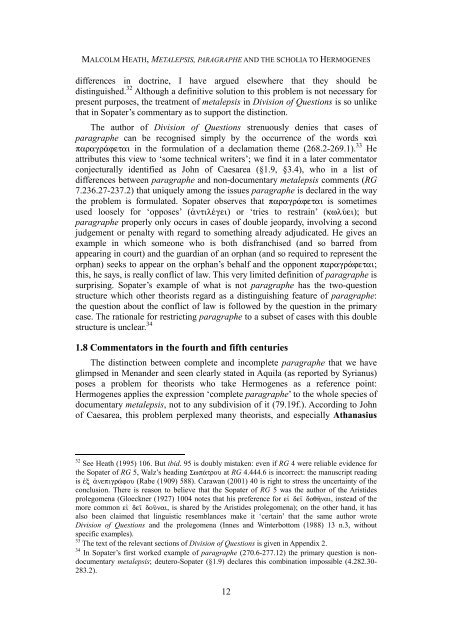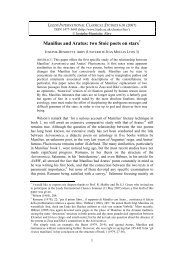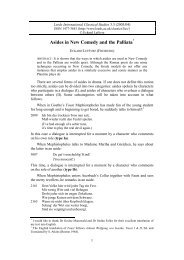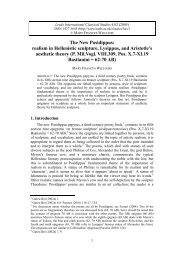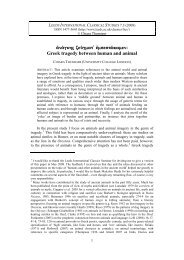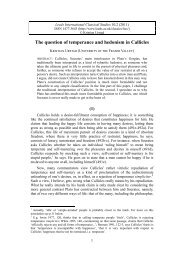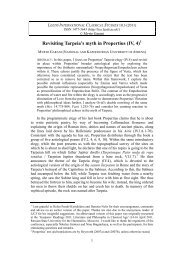Metalepsis, paragraphe and the scholia to Hermogenes - Leeds ...
Metalepsis, paragraphe and the scholia to Hermogenes - Leeds ...
Metalepsis, paragraphe and the scholia to Hermogenes - Leeds ...
Create successful ePaper yourself
Turn your PDF publications into a flip-book with our unique Google optimized e-Paper software.
MALCOLM HEATH, METALEPSIS, PARAGRAPHE AND THE SCHOLIA TO HERMOGENES<br />
differences in doctrine, I have argued elsewhere that <strong>the</strong>y should be<br />
distinguished. 32 Although a definitive solution <strong>to</strong> this problem is not necessary for<br />
present purposes, <strong>the</strong> treatment of metalepsis in Division of Questions is so unlike<br />
that in Sopater’s commentary as <strong>to</strong> support <strong>the</strong> distinction.<br />
The author of Division of Questions strenuously denies that cases of<br />
<strong>paragraphe</strong> can be recognised simply by <strong>the</strong> occurrence of <strong>the</strong> words kaˆ<br />
paragr£fetai in <strong>the</strong> formulation of a declamation <strong>the</strong>me (268.2-269.1). 33 He<br />
attributes this view <strong>to</strong> ‘some technical writers’; we find it in a later commenta<strong>to</strong>r<br />
conjecturally identified as John of Caesarea (§1.9, §3.4), who in a list of<br />
differences between <strong>paragraphe</strong> <strong>and</strong> non-documentary metalepsis comments (RG<br />
7.236.27-237.2) that uniquely among <strong>the</strong> issues <strong>paragraphe</strong> is declared in <strong>the</strong> way<br />
<strong>the</strong> problem is formulated. Sopater observes that paragr£fetai is sometimes<br />
used loosely for ‘opposes’ (¢ntilšgei) or ‘tries <strong>to</strong> restrain’ (kwlÚei); but<br />
<strong>paragraphe</strong> properly only occurs in cases of double jeopardy, involving a second<br />
judgement or penalty with regard <strong>to</strong> something already adjudicated. He gives an<br />
example in which someone who is both disfranchised (<strong>and</strong> so barred from<br />
appearing in court) <strong>and</strong> <strong>the</strong> guardian of an orphan (<strong>and</strong> so required <strong>to</strong> represent <strong>the</strong><br />
orphan) seeks <strong>to</strong> appear on <strong>the</strong> orphan’s behalf <strong>and</strong> <strong>the</strong> opponent paragr£fetai;<br />
this, he says, is really conflict of law. This very limited definition of <strong>paragraphe</strong> is<br />
surprising. Sopater’s example of what is not <strong>paragraphe</strong> has <strong>the</strong> two-question<br />
structure which o<strong>the</strong>r <strong>the</strong>orists regard as a distinguishing feature of <strong>paragraphe</strong>:<br />
<strong>the</strong> question about <strong>the</strong> conflict of law is followed by <strong>the</strong> question in <strong>the</strong> primary<br />
case. The rationale for restricting <strong>paragraphe</strong> <strong>to</strong> a subset of cases with this double<br />
structure is unclear. 34<br />
1.8 Commenta<strong>to</strong>rs in <strong>the</strong> fourth <strong>and</strong> fifth centuries<br />
The distinction between complete <strong>and</strong> incomplete <strong>paragraphe</strong> that we have<br />
glimpsed in Men<strong>and</strong>er <strong>and</strong> seen clearly stated in Aquila (as reported by Syrianus)<br />
poses a problem for <strong>the</strong>orists who take <strong>Hermogenes</strong> as a reference point:<br />
<strong>Hermogenes</strong> applies <strong>the</strong> expression ‘complete <strong>paragraphe</strong>’ <strong>to</strong> <strong>the</strong> whole species of<br />
documentary metalepsis, not <strong>to</strong> any subdivision of it (79.19f.). According <strong>to</strong> John<br />
of Caesarea, this problem perplexed many <strong>the</strong>orists, <strong>and</strong> especially Athanasius<br />
32 See Heath (1995) 106. But ibid. 95 is doubly mistaken: even if RG 4 were reliable evidence for<br />
<strong>the</strong> Sopater of RG 5, Walz’s heading Swp£trou at RG 4.444.6 is incorrect: <strong>the</strong> manuscript reading<br />
is x ¢nepigr£fou (Rabe (1909) 588). Carawan (2001) 40 is right <strong>to</strong> stress <strong>the</strong> uncertainty of <strong>the</strong><br />
conclusion. There is reason <strong>to</strong> believe that <strong>the</strong> Sopater of RG 5 was <strong>the</strong> author of <strong>the</strong> Aristides<br />
prolegomena (Gloeckner (1927) 1004 notes that his preference for e„ de‹ doqÁnai, instead of <strong>the</strong><br />
more common e„ de‹ doànai, is shared by <strong>the</strong> Aristides prolegomena); on <strong>the</strong> o<strong>the</strong>r h<strong>and</strong>, it has<br />
also been claimed that linguistic resemblances make it ‘certain’ that <strong>the</strong> same author wrote<br />
Division of Questions <strong>and</strong> <strong>the</strong> prolegomena (Innes <strong>and</strong> Winterbot<strong>to</strong>m (1988) 13 n.3, without<br />
specific examples).<br />
33 The text of <strong>the</strong> relevant sections of Division of Questions is given in Appendix 2.<br />
34 In Sopater’s first worked example of <strong>paragraphe</strong> (270.6-277.12) <strong>the</strong> primary question is nondocumentary<br />
metalepsis; deutero-Sopater (§1.9) declares this combination impossible (4.282.30-<br />
283.2).<br />
12


